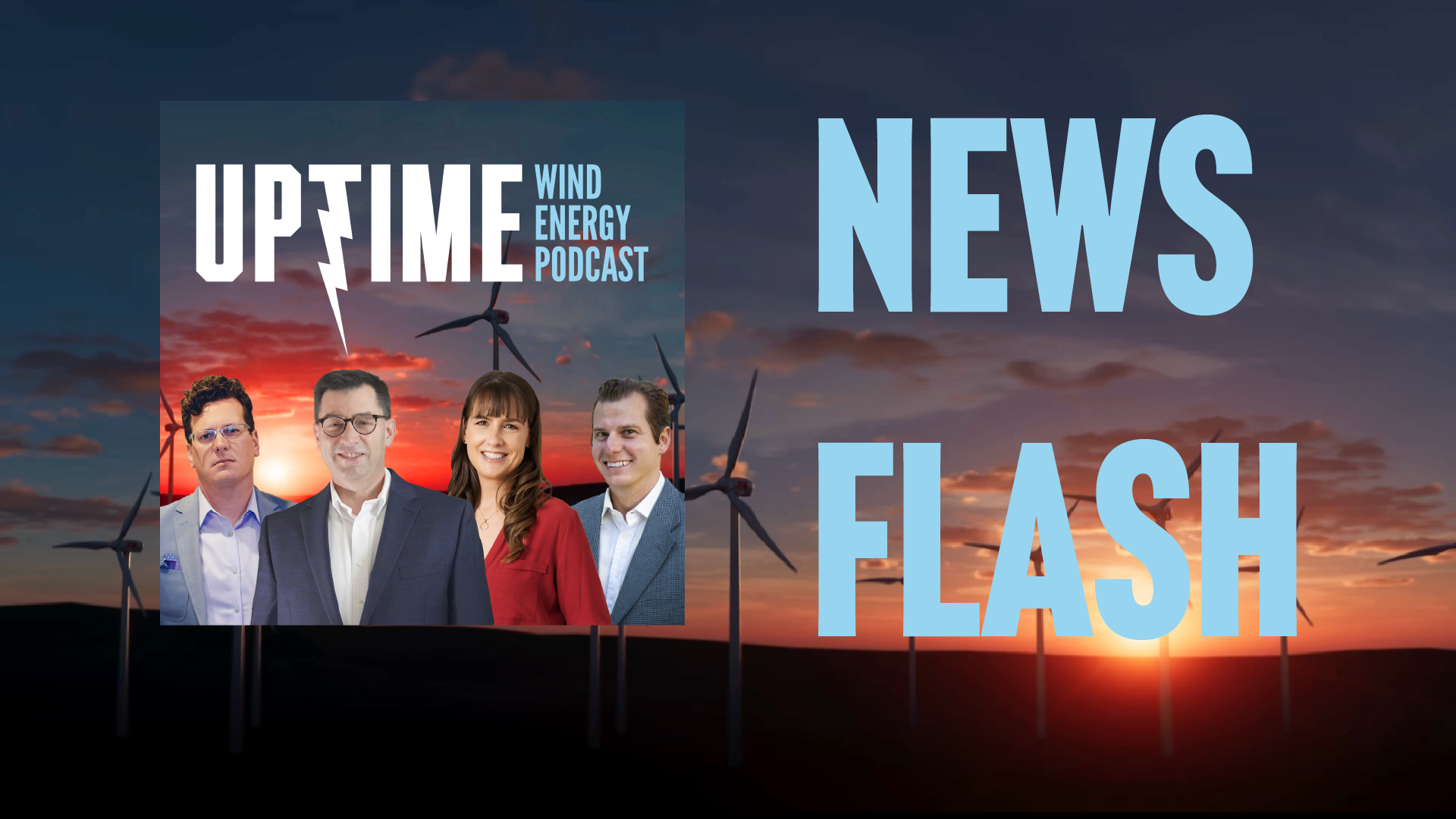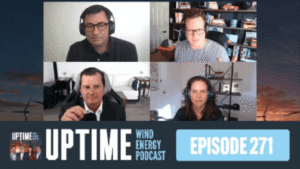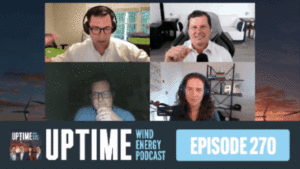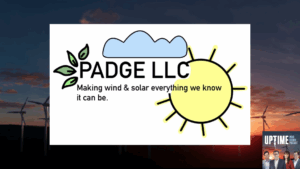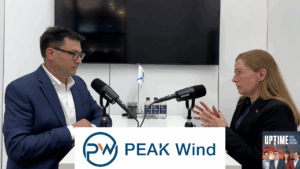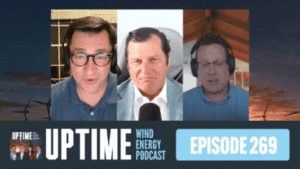Podcast: Play in new window | Download
BP has decided to sell its onshore wind business in the US, aligning with the company’s return focusing on oil and gas. GE Vernova has partnered with Italian company Lizard Renewables to develop over a gigawatt of renewable power in Italy. Engie has added Ares Management as a partner in a 2.7 gigawatt portfolio in North America.
Sign up now for Uptime Tech News, our weekly email update on all things wind technology. This episode is sponsored by Weather Guard Lightning Tech. Learn more about Weather Guard’s StrikeTape Wind Turbine LPS retrofit. Follow the show on Facebook, YouTube, Twitter, Linkedin and visit Weather Guard on the web. And subscribe to Rosemary Barnes’ YouTube channel here. Have a question we can answer on the show? Email us!
Pardalote Consulting – https://www.pardaloteconsulting.com
Weather Guard Lightning Tech – www.weatherguardwind.com
Intelstor – https://www.intelstor.com
NF92324
Allen Hall: I’m Allen Hall, president of Weather Guard Lightning Tech, and I’m here with the founder and CEO of IntelStor, Phil Totaro, and the chief commercial officer of Weather Guard Lightning Tech, Joel Saxum. And this is your News Flash. Newsflash is brought to you by our friends at IntelStor. If you want market intelligence that generates revenue, then book a demonstration of IntelStor at IntelStor. com
French power utility Engie has partnered with Ares management in a significant us renewable energy deal. Engie North America has attracted Ares management infrastructure opportunities fund as a minority partner in a 2. 7 gigawatt portfolio. of operational solar, wind, and co located storage assets across the U.
S. This transaction, NJ’s largest operating portfolio sell down in the U. S., involves 15 plants across ERCOT, MESO, PJM, and SPP. Okay, Phil, a lot of acquisitions and mergers happening again, this time with Engie.
Philip Totaro: Yeah, this one is Interesting a little bit because it’s More or less their first foray besides what they’ve done in offshore.
It’s one of their first kind of forays into significant minority ownership from a financially focused partner And, Ares obviously has an appetite. Ares owns a few other assets in the U. S., either majority or significant minority as well. And so to add this kind of a portfolio to the mix gives both companies, It helps both companies achieve what they want in terms of, freeing up some additional capital for Engie to go reinvest in other projects and, bringing on a partner that wants financially viable assets in their, in their portfolio mix.
So, look, we’ve talked about a number of these kinds of deals in the past where, a financially focused company gets into a portfolio, either minority, majority but partners in some way, shape, or form with an experienced owner and operator and it’s, it’s good to see this, this matchup.
And I would expect if there’s anyone else out there that hasn’t already, executed deals like this, they are probably looking to go in this direction because there is a lot of capital that it’s sitting on the sidelines right now. You’re, you’re not seeing tons and tons of new capital go into new project build out because of interest rates and et cetera.
But there is capital kind of sitting on the sidelines that wants to be able to get into renewables. This is still one way they can do that by partnering on a pre existing portfolio.
Joel Saxum: And from an operational standpoint, Ares just, I think, a few years ago acquired the majority stake in Apex Clean Energy.
And when that happened, I know the Apex Teams ended up operating their assets more themselves. So, and where they were traditionally kind of like letting other ISPs or whatever, or, or FSAs manage them, they turned into a different financial model. So you can look for some of these assets that Engie manages right now with the Ares funds and to possibly adjust how they manage these things.
from a operational standpoint as well. But like Phil said, a lot of, a lot of moving parts here, and this is a way to put capital to work.
Allen Hall: BP has announced plans to sell its U. S. onshore wind energy business. The company will soon launch the sale process for BP Wind Energy, which has interest in 10 operating onshore wind assets across seven U.
S. states, with a total net generating capacity of 1. 3 gigawatts. BP executive William Lin stated that the business is likely to be of greater value for another owner. Bill, a lot of oil and gas based businesses that have been in renewables for several years are pushing back into oil and gas because of interest rates.
But there’s also something more at play about scale I think here with BP. There is a big push to be big in wind or to be big in solar and BP doesn’t want to take that step at the moment.
Philip Totaro: Yeah, well, I mean, Allen, not for nothing, it’s been 15 years of them not really wanting to take that step, to be perfectly blunt about it and, and it’s unfortunate because they could have, poured a lot of money in.
But they also had a bit of a sour taste in their mouth because when, even 15 years ago, when they did start investing in some of these wind farms, they probably thought they were going to be a easier to operate and own and be more profitable to operate and own than what they ended up being.
Now, that said, a lot of this 1. 3 gigawatts of portfolio that they’re selling or offering for sale is likely to be repowered if there’s a couple of projects that have already been recently, but we’ll This is largely a repower play for somebody that wants to get in on something that’s probably, at least 10 years old.
I’d say the vast majority of this portfolio is, 10 years old or older. So you can qualify for a PTC repowering on this. It’s sad from the perspective of, oil and gas companies just saying, you know what, we tried renewables, it wasn’t profitable enough, so we’re dumping out of it for the most part, and maybe we’ll come back in later when it looks like it’s more profitable again.
Which is an easy thing to do when you’ve got piles and piles of cash like they do. And, right now it’s more profitable to just do oil and gas than it is So when we see oil and gas prices go down and, profits from renewables go back up, you’ll see these guys come back, but it’s a good way to, to, um, recycle, so to speak some some assets and, and allow someone else to, to take over and, and repower them while they redeploy capital elsewhere.
Joel Saxum: Yeah, this is a, like we’ve talked about, this is a trend, these major oil and gas companies. What, what drives it? Returns for stakeholders, returns for shareholders, the Wall Street stuff. When BP’s changed over CEOs in the last, in the last year, the message was clear, we’re going to do what we can to drive profits for our stakeholders and in oil and gas, there’s just higher margins than there is in, in the wind industry or renewables industry.
However, of course, as a renewables industry, we want to see the transition move forward. So. Hoping that when things move a little bit further along here, you see some of that capital redeployed and do the renewable energy generation sector. But for right now BP putting their own money elsewhere.
Allen Hall: Lastly, GE Vernova has formed a joint venture with Italian renewables company, Lazard Renewables to develop over one gigawatts of wind, solar, and battery. Energy storage projects in Italy, the 50 50 joint venture named Alva Power, will initially work on bringing this portfolio to the ready to build stage, with Lazard having already selected and prepared the projects.
The partnership aims to contribute to Italy’s renewable energy targets of 30 percent renewables in total energy consumption and 55 percent renewables in electricity generation. By 2030 bill, Italy has become a kind of a renewables battleground between Chinese manufacturers and now G. E. Vernova is this makes sense to, to partner with a large player like Lazard, where you’re highly integrated into the Italian grid.
Philip Totaro: It does for GE and this deal is actually particularly kind of interesting to me because anything that is a GE turbine that’s already been previously deployed in Italy is either a 1. 5 megawatt or the, the 2. 5 120 platform. That was, that was pretty popular, but even a lot of those are getting to be, those assets are getting to be at least 10 years old or older.
He, GE hasn’t been particularly successful in selling a lot of their existing product portfolio into the Italian market. So a development partnership. Seems like the way to go in Strategic markets like this where yes, there’s been some kind of competition you could say from from companies like gold wind onshore although it’s it gets blown out of proportion a little bit, but The reality for ge is that they need a partnership like this to be able to continue selling, newer models in, in a market like Italy, which, is an important, they’ve got 9, 000 turbines over there, and a lot of them are going to need to be repowered as well in, in the coming, five years, you’re going to have an opportunity to take advantage of by establishing this kind of this kind of a JV.
Joel Saxum: So as well to the listeners, this isn’t the first of its kind of a JV or a. OEM being or having a development arm, but the ones that like a Vestas has had it in the past as well. But what the goal of most of these are is to build out a pipeline and go through the permitting processes, go through all of the, the government rigamarole and into getting the transmission connection stuff, but not actually.
Putting assets in the ground. Once they get to that stage, sometimes they they’ll bring in another group to actually do construction and then operations, maintenance, and that, those kinds of things. But what it is, is it’s them getting everything ready to go with a earmark for their turbines to go into that project.
And then they usually pass it off. So as like Phil says, it’s a great move by GE to get some more of their kit deployed in the Italian market. And that market used to it. So, Hey, you got to repower coming up all the down the road. There’s a new GE turbines. Why don’t we take a look at those? So that’s a, that’s a good play.



